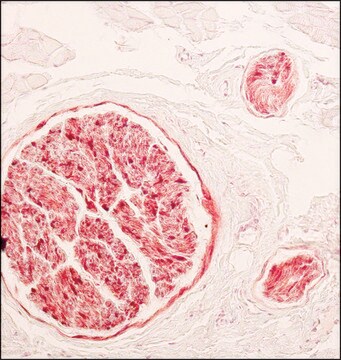AB7356
Anti-von Willebrand Factor Antibody
Chemicon®, from rabbit
Sinonimo/i:
Factor VIII Related Antigen
About This Item
Prodotti consigliati
Origine biologica
rabbit
Livello qualitativo
Forma dell’anticorpo
purified immunoglobulin
Tipo di anticorpo
primary antibodies
Clone
polyclonal
Reattività contro le specie
human, rat, mouse
Confezionamento
antibody small pack of 25 μg
Produttore/marchio commerciale
Chemicon®
tecniche
ELISA: suitable
immunohistochemistry: suitable (paraffin)
N° accesso NCBI
N° accesso UniProt
Condizioni di spedizione
ambient
Temperatura di conservazione
2-8°C
modifica post-traduzionali bersaglio
unmodified
Informazioni sul gene
human ... F8(302470) , VWF(7450)
rat ... F8(302470)
Descrizione generale
Specificità
Immunogeno
Applicazioni
ELISA Analysis: A representative lot detected von Willebrand Factor in ELISA applications.
Immunohistochemistry Analysis: A 1:250-1,000 dilution from a representative lot detected von Willebrand Factor in human cerebral cortex, mouse hippocampus, rat cerebellum and human tonsil tissue sections.
Cell Structure
ECM Proteins
Qualità
Representative images from a previous lot.
Rabbit anti-vWF (AB7356) staining of Human Cerebral Cortex. Tissue pretreated with Citrate Buffer, ph 6.0, anti-vWF at 20 μg/mL, IHC-Select Detection with HRP-DAB.
Descrizione del bersaglio
Stato fisico
Stoccaggio e stabilità
Altre note
Note legali
Esclusione di responsabilità
Not finding the right product?
Try our Motore di ricerca dei prodotti.
Raccomandato
Codice della classe di stoccaggio
12 - Non Combustible Liquids
Classe di pericolosità dell'acqua (WGK)
WGK 2
Punto d’infiammabilità (°F)
Not applicable
Punto d’infiammabilità (°C)
Not applicable
Certificati d'analisi (COA)
Cerca il Certificati d'analisi (COA) digitando il numero di lotto/batch corrispondente. I numeri di lotto o di batch sono stampati sull'etichetta dei prodotti dopo la parola ‘Lotto’ o ‘Batch’.
Possiedi già questo prodotto?
I documenti relativi ai prodotti acquistati recentemente sono disponibili nell’Archivio dei documenti.
I clienti hanno visto anche
Il team dei nostri ricercatori vanta grande esperienza in tutte le aree della ricerca quali Life Science, scienza dei materiali, sintesi chimica, cromatografia, discipline analitiche, ecc..
Contatta l'Assistenza Tecnica.







